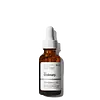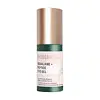What's inside
What's inside
 Key Ingredients
Key Ingredients

 Benefits
Benefits

 Concerns
Concerns

 Ingredients Side-by-side
Ingredients Side-by-side

Water
Skin ConditioningCaffeine
Skin ConditioningMaltodextrin
AbsorbentGlycerin
HumectantPropanediol
SolventEpigallocatechin Gallatyl Glucoside
AntioxidantGallyl Glucoside
AntioxidantHyaluronic Acid
HumectantOxidized Glutathione
EmollientMelanin
Skin ProtectingGlycine Soja Seed Extract
Skin ConditioningPentylene Glycol
Skin ConditioningHydroxyethylcellulose
Emulsion StabilisingPolyacrylate Crosspolymer-6
Emulsion StabilisingXanthan Gum
EmulsifyingLactic Acid
BufferingDehydroacetic Acid
PreservativeTrisodium Ethylenediamine Disuccinate
Propyl Gallate
AntioxidantDimethyl Isosorbide
SolventBenzyl Alcohol
Perfuming1,2-Hexanediol
Skin ConditioningEthylhexylglycerin
Skin ConditioningPhenoxyethanol
PreservativeCaprylyl Glycol
EmollientWater, Caffeine, Maltodextrin, Glycerin, Propanediol, Epigallocatechin Gallatyl Glucoside, Gallyl Glucoside, Hyaluronic Acid, Oxidized Glutathione, Melanin, Glycine Soja Seed Extract, Pentylene Glycol, Hydroxyethylcellulose, Polyacrylate Crosspolymer-6, Xanthan Gum, Lactic Acid, Dehydroacetic Acid, Trisodium Ethylenediamine Disuccinate, Propyl Gallate, Dimethyl Isosorbide, Benzyl Alcohol, 1,2-Hexanediol, Ethylhexylglycerin, Phenoxyethanol, Caprylyl Glycol
Water
Skin ConditioningAloe Barbadensis Leaf Juice
Skin ConditioningSqualane
EmollientNiacinamide
SmoothingGlycerin
HumectantPanthenol
Skin ConditioningChondrus Crispus Extract
Skin ConditioningMalus Domestica Fruit Cell Culture Extract
Skin ConditioningAcetyl Tetrapeptide-5
HumectantAcetyl Hexapeptide-8
HumectantTocopherol
AntioxidantPentylene Glycol
Skin ConditioningCucumis Sativus Fruit Extract
EmollientTetrahexyldecyl Ascorbate
AntioxidantCamellia Sinensis Leaf Extract
AntimicrobialLycium Barbarum Fruit Extract
AstringentLycopene
AntioxidantVitis Vinifera Skin Extract
AntioxidantSodium Hyaluronate
HumectantCaffeine
Skin ConditioningAcacia Senegal Gum
MaskingDimethicone Crosspolymer
Emulsion StabilisingXanthan Gum
EmulsifyingCarbomer
Emulsion StabilisingEthyl Lauroyl Arginate Hcl
Skin ConditioningLecithin
EmollientAmmonium Acryloyldimethyltaurate/Vp Copolymer
Silica
AbrasivePhenoxyethanol
PreservativePotassium Sorbate
PreservativeCitric Acid
BufferingCaprylyl Glycol
EmollientWater, Aloe Barbadensis Leaf Juice, Squalane, Niacinamide, Glycerin, Panthenol, Chondrus Crispus Extract, Malus Domestica Fruit Cell Culture Extract, Acetyl Tetrapeptide-5, Acetyl Hexapeptide-8, Tocopherol, Pentylene Glycol, Cucumis Sativus Fruit Extract, Tetrahexyldecyl Ascorbate, Camellia Sinensis Leaf Extract, Lycium Barbarum Fruit Extract, Lycopene, Vitis Vinifera Skin Extract, Sodium Hyaluronate, Caffeine, Acacia Senegal Gum, Dimethicone Crosspolymer, Xanthan Gum, Carbomer, Ethyl Lauroyl Arginate Hcl, Lecithin, Ammonium Acryloyldimethyltaurate/Vp Copolymer, Silica, Phenoxyethanol, Potassium Sorbate, Citric Acid, Caprylyl Glycol
 Reviews
Reviews

Ingredients Explained
These ingredients are found in both products.
Ingredients higher up in an ingredient list are typically present in a larger amount.
Caffeine is most associated with coffee, tea, and cacao. In skincare, it helps with calming inflammation and is rich in antioxidants.
While caffeine is used to treat cellulite and and dark circles, further studies are needed to prove this. It has been believed to help with these skin conditions due to its ability to dilate blood vessels and increase blood flow.
Some studies are looking into caffeine's ability to protect against UV rays.
Learn more about CaffeineCaprylyl Glycol is a humectant and emollient, meaning it attracts and preserves moisture.
It is a common ingredient in many products, especially those designed to hydrate skin. The primary benefits are retaining moisture, skin softening, and promoting a healthy skin barrier.
Though Caprylyl Glycol is an alcohol derived from fatty acids, it is not the kind that can dry out skin.
This ingredient is also used as a preservative to extend the life of products. It has slight antimicrobial properties.
Learn more about Caprylyl GlycolGlycerin is already naturally found in your skin. It helps moisturize and protect your skin.
A study from 2016 found glycerin to be more effective as a humectant than AHAs and hyaluronic acid.
As a humectant, it helps the skin stay hydrated by pulling moisture to your skin. The low molecular weight of glycerin allows it to pull moisture into the deeper layers of your skin.
Hydrated skin improves your skin barrier; Your skin barrier helps protect against irritants and bacteria.
Glycerin has also been found to have antimicrobial and antiviral properties. Due to these properties, glycerin is often used in wound and burn treatments.
In cosmetics, glycerin is usually derived from plants such as soybean or palm. However, it can also be sourced from animals, such as tallow or animal fat.
This ingredient is organic, colorless, odorless, and non-toxic.
Glycerin is the name for this ingredient in American English. British English uses Glycerol/Glycerine.
Learn more about GlycerinPentylene glycol is typically used within a product to thicken it. It also adds a smooth, soft, and moisturizing feel to the product. It is naturally found in plants such as sugar beets.
The hydrophilic trait of Pentylene Glycol makes it a humectant. As a humectant, Pentylene Glycol helps draw moisture from the air to your skin. This can help keep your skin hydrated.
This property also makes Pentylene Glycol a great texture enhancer. It can also help thicken or stabilize a product.
Pentylene Glycol also acts as a mild preservative and helps to keep a product microbe-free.
Some people may experience mild eye and skin irritation from Pentylene Glycol. We always recommend speaking with a professional about using this ingredient in your routine.
Pentylene Glycol has a low molecular weight and is part of the 1,2-glycol family.
Learn more about Pentylene GlycolPhenoxyethanol is a preservative that has germicide, antimicrobial, and aromatic properties. Studies show that phenoxyethanol can prevent microbial growth. By itself, it has a scent that is similar to that of a rose.
It's often used in formulations along with Caprylyl Glycol to preserve the shelf life of products.
Water. It's the most common cosmetic ingredient of all. You'll usually see it at the top of ingredient lists, meaning that it makes up the largest part of the product.
So why is it so popular? Water most often acts as a solvent - this means that it helps dissolve other ingredients into the formulation.
You'll also recognize water as that liquid we all need to stay alive. If you see this, drink a glass of water. Stay hydrated!
Learn more about WaterXanthan gum is used as a stabilizer and thickener within cosmetic products. It helps give products a sticky, thick feeling - preventing them from being too runny.
On the technical side of things, xanthan gum is a polysaccharide - a combination consisting of multiple sugar molecules bonded together.
Xanthan gum is a pretty common and great ingredient. It is a natural, non-toxic, non-irritating ingredient that is also commonly used in food products.
Learn more about Xanthan Gum